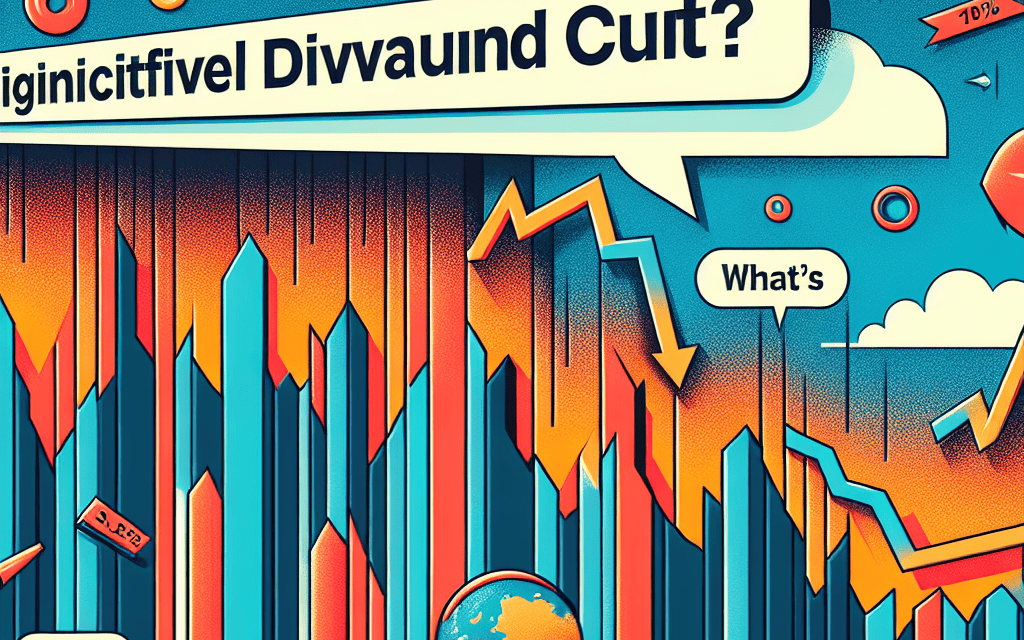“Market Shock: Materials Stock Tumbles Amidst Unexpected Dividend Slash”
Introduction
Shares of a leading materials company have experienced a significant decline following the announcement of a major dividend cut, raising concerns among investors and market analysts. The unexpected decision to reduce dividend payouts has sparked a wave of uncertainty, prompting questions about the company’s financial health and future prospects. This move, often seen as a last resort to conserve cash, has led to speculation about underlying issues within the company, such as declining revenues, increased debt, or strategic shifts in business operations. As stakeholders seek clarity, the market is closely monitoring the situation to understand the broader implications for the materials sector and the potential ripple effects on related industries.
Impact Of Dividend Cuts On Stock Prices In The Materials Sector
The recent announcement of a significant dividend cut by a leading company in the materials sector has sent shockwaves through the stock market, causing a notable plummet in the company’s stock price. This development has raised concerns among investors and analysts alike, prompting a closer examination of the impact of dividend cuts on stock prices within the materials sector. Understanding the dynamics at play requires an exploration of the relationship between dividend policies and investor sentiment, as well as the broader implications for the sector.
Dividend cuts are often perceived as a red flag by investors, signaling potential financial distress or a shift in corporate strategy. In the materials sector, where companies are heavily reliant on capital-intensive operations and cyclical demand, maintaining investor confidence is crucial. When a company announces a reduction in dividends, it can be interpreted as an indication that the company is facing challenges in generating sufficient cash flow or is reallocating resources to address pressing operational needs. Consequently, investors may react by selling off shares, leading to a decline in stock prices.
Moreover, the materials sector is particularly sensitive to changes in economic conditions, as it encompasses industries such as mining, construction, and chemicals, which are closely tied to global economic cycles. A dividend cut in this sector can exacerbate concerns about the health of the broader economy, especially if it coincides with other negative indicators such as declining commodity prices or reduced industrial activity. This interconnectedness means that a dividend cut can have a ripple effect, influencing investor perceptions not only of the individual company but also of the sector as a whole.
In addition to immediate market reactions, dividend cuts can have longer-term implications for a company’s stock price. Investors often view dividends as a sign of a company’s financial stability and its commitment to returning value to shareholders. A reduction in dividends may lead to a reassessment of the company’s growth prospects and its ability to generate sustainable returns. This can result in a reevaluation of the company’s valuation, potentially leading to a prolonged period of stock price underperformance compared to peers that maintain or increase their dividend payouts.
However, it is important to consider that not all dividend cuts are indicative of underlying financial weakness. In some cases, companies may choose to cut dividends as part of a strategic realignment, redirecting funds towards growth initiatives or debt reduction. While this may initially unsettle investors, it can ultimately strengthen the company’s financial position and enhance long-term shareholder value. Therefore, investors should carefully assess the rationale behind a dividend cut and consider the company’s overall strategic direction before making investment decisions.
In conclusion, the impact of dividend cuts on stock prices in the materials sector is multifaceted, influenced by investor perceptions, economic conditions, and company-specific factors. While a dividend cut can trigger an immediate negative reaction in the stock market, its long-term effects depend on the underlying reasons for the cut and the company’s ability to navigate challenges and capitalize on opportunities. As such, investors should adopt a nuanced approach, balancing short-term market reactions with a comprehensive analysis of the company’s strategic outlook and the broader sectoral context.
Analyzing The Reasons Behind The Recent Dividend Cut In Materials Stocks
The recent downturn in materials stocks has sent ripples through the financial markets, primarily triggered by a significant dividend cut that has left investors and analysts alike scrambling for answers. This unexpected move has raised questions about the underlying factors contributing to such a drastic decision. To comprehend the rationale behind the dividend cut, it is essential to delve into the broader economic and industry-specific conditions that have influenced this outcome.
Firstly, the global economic landscape has been fraught with uncertainty, marked by fluctuating commodity prices and geopolitical tensions. These factors have exerted considerable pressure on the materials sector, which is heavily reliant on stable demand and pricing for raw materials. As commodity prices have experienced volatility, companies within the sector have faced challenges in maintaining profitability. Consequently, the need to preserve cash flow and strengthen balance sheets has become paramount, prompting some firms to reconsider their dividend policies.
Moreover, the materials sector is not immune to the impacts of supply chain disruptions, which have been exacerbated by the lingering effects of the COVID-19 pandemic. These disruptions have led to increased operational costs and delays in production, further straining the financial health of companies. In response, management teams have been compelled to adopt more conservative financial strategies, including the reduction of dividend payouts, to ensure long-term sustainability.
In addition to these macroeconomic factors, company-specific issues have also played a role in the decision to cut dividends. For instance, some firms have embarked on ambitious capital expenditure programs aimed at modernizing facilities and investing in new technologies. While these initiatives are crucial for maintaining competitive advantage, they require substantial financial resources. As a result, companies may opt to reallocate funds from dividends to support these strategic investments, thereby enhancing their future growth prospects.
Furthermore, regulatory changes and environmental considerations have increasingly influenced corporate decision-making within the materials sector. With growing emphasis on sustainability and reducing carbon footprints, companies are under pressure to comply with stringent environmental regulations. This often necessitates significant investment in cleaner technologies and processes, which can strain financial resources. Consequently, firms may choose to cut dividends as a means of redirecting funds towards meeting these regulatory requirements and achieving sustainability goals.
It is also important to consider the role of investor sentiment in the wake of a dividend cut. While such a move may initially trigger a negative reaction in the stock market, it is crucial for investors to assess the long-term implications. A dividend cut, though seemingly unfavorable, can be a prudent decision if it positions the company for future growth and stability. By prioritizing financial health and strategic investments, companies can potentially enhance shareholder value over time, despite the short-term impact on stock prices.
In conclusion, the recent dividend cut in materials stocks can be attributed to a confluence of factors, including economic volatility, supply chain challenges, strategic investments, regulatory pressures, and the need for financial prudence. While the immediate market reaction may be negative, it is essential to recognize that such decisions are often made with a view towards ensuring long-term sustainability and growth. As the materials sector navigates these complex challenges, investors and stakeholders must remain vigilant and informed, understanding that short-term sacrifices may pave the way for future success.
Investor Reactions To Dividend Reductions In The Materials Industry
The recent announcement of a significant dividend cut by a leading company in the materials industry has sent shockwaves through the investment community, resulting in a sharp decline in the company’s stock price. This development has prompted investors to reassess their positions and consider the broader implications for the sector. Dividend reductions are often perceived as a red flag, signaling potential financial distress or a strategic shift in company priorities. Consequently, the market’s reaction to such announcements is typically swift and severe, as evidenced by the recent plummet in the materials stock.
Investors generally view dividends as a sign of a company’s financial health and stability. Regular and increasing dividends are often interpreted as indicators of robust cash flow and a strong balance sheet. Therefore, when a company decides to cut its dividend, it can lead to a loss of investor confidence. This is particularly true in the materials industry, where companies are heavily reliant on commodity prices and global economic conditions, which can be volatile and unpredictable. The recent dividend cut has raised concerns about the company’s ability to generate consistent cash flow in the face of fluctuating market conditions.
Moreover, the materials industry is capital-intensive, requiring significant investment in infrastructure, technology, and human resources. Companies in this sector often face the challenge of balancing the need for reinvestment with the desire to return capital to shareholders. A dividend cut may suggest that a company is prioritizing internal investments over shareholder returns, which can be a prudent long-term strategy but may not be well-received by investors focused on immediate returns. This tension between short-term expectations and long-term planning is a critical factor in the market’s reaction to dividend reductions.
In addition to the immediate financial implications, a dividend cut can also affect a company’s reputation and investor relations. Companies that have established a track record of reliable dividend payments may find it challenging to rebuild trust with investors after a reduction. This can lead to increased scrutiny from analysts and a more cautious approach from institutional investors, who may choose to reallocate their portfolios in response to perceived risks. The materials industry, with its inherent exposure to economic cycles and geopolitical factors, is particularly susceptible to such shifts in investor sentiment.
Furthermore, the broader economic environment plays a crucial role in shaping investor reactions to dividend cuts. In times of economic uncertainty or downturns, investors may be more forgiving of dividend reductions, recognizing the need for companies to preserve cash and maintain operational flexibility. However, in a stable or growing economy, dividend cuts can be seen as a sign of underlying weaknesses or mismanagement, prompting a more negative response from the market.
In conclusion, the recent dividend cut in the materials industry has underscored the complex interplay between company strategy, investor expectations, and market conditions. While the immediate impact on stock prices has been negative, the long-term effects will depend on the company’s ability to navigate the challenges it faces and communicate its strategic vision to investors. As the materials industry continues to evolve, companies must carefully balance the demands of reinvestment and shareholder returns to maintain investor confidence and support sustainable growth.
Long-Term Implications Of Dividend Cuts For Materials Companies

The recent decision by a leading materials company to significantly reduce its dividend has sent shockwaves through the market, causing its stock to plummet and raising concerns about the long-term implications for the sector. Dividend cuts are often perceived as a red flag, signaling potential financial distress or a strategic shift in capital allocation. For materials companies, which are typically valued for their stable cash flows and reliable dividend payouts, such a move can have profound implications on investor confidence and market perception.
To understand the long-term implications of dividend cuts for materials companies, it is essential to consider the underlying reasons for such decisions. Often, these cuts are driven by a need to preserve cash in response to declining revenues or increased operational costs. In the materials sector, which is heavily influenced by global economic conditions and commodity price fluctuations, companies may face periods of reduced demand or price volatility that necessitate a reevaluation of their financial strategies. By cutting dividends, a company can redirect funds towards debt reduction, capital investments, or other strategic initiatives aimed at ensuring long-term sustainability.
However, while the intention behind a dividend cut may be to strengthen the company’s financial position, the immediate market reaction is typically negative. Investors, particularly those who rely on dividend income, may view the cut as a loss of income and a sign of potential trouble ahead. This can lead to a sell-off of the company’s stock, as seen in the recent case, further exacerbating the decline in market value. Moreover, a dividend cut can alter the company’s investor base, as income-focused investors may exit in favor of growth-oriented or more stable dividend-paying stocks.
In the long term, the impact of a dividend cut on a materials company depends on its ability to effectively communicate its strategic vision and demonstrate improved financial performance. Transparency is crucial; companies must clearly articulate the reasons for the dividend cut and outline how the reallocated funds will be used to drive growth or enhance operational efficiency. By doing so, they can rebuild investor trust and potentially attract a new cohort of investors who are more aligned with the company’s revised strategic goals.
Furthermore, the broader implications for the materials sector should not be overlooked. A dividend cut by a major player can set a precedent, prompting other companies in the sector to reassess their own dividend policies. This could lead to a shift in how materials companies are valued, with greater emphasis placed on growth potential and operational resilience rather than just dividend yield. Consequently, companies may need to innovate and diversify their operations to remain competitive and appealing to investors.
In conclusion, while a dividend cut can initially be perceived as a negative development, it also presents an opportunity for materials companies to realign their financial strategies and focus on long-term growth. The key lies in effective communication and execution of strategic initiatives that can enhance the company’s financial health and market position. As the sector navigates these challenges, the ability to adapt and respond to changing market dynamics will be crucial in determining the long-term implications of dividend cuts for materials companies.
Comparing Dividend Policies Across The Materials Sector
The recent plummet in materials stock following a significant dividend cut has sparked considerable interest and concern among investors and analysts alike. To understand the broader implications of this event, it is essential to compare dividend policies across the materials sector, as these policies can vary significantly and impact investor sentiment and stock performance.
Dividend policies in the materials sector are often influenced by a company’s financial health, market conditions, and strategic priorities. Companies in this sector, which includes industries such as mining, chemicals, and construction materials, typically generate substantial cash flow. This financial strength allows many of them to offer attractive dividends to shareholders. However, the cyclical nature of the materials sector means that these companies must also be prepared to adjust their dividend policies in response to fluctuating commodity prices and economic conditions.
In recent years, some materials companies have adopted more conservative dividend policies, prioritizing financial stability over high payouts. This approach often involves maintaining a lower payout ratio, which is the proportion of earnings paid out as dividends. By doing so, these companies aim to retain more earnings to reinvest in their operations or to buffer against economic downturns. This strategy can be particularly beneficial during periods of market volatility, as it allows companies to sustain their dividend payments even when profits decline.
Conversely, other companies in the materials sector have chosen to maintain or even increase their dividend payouts, viewing them as a critical component of shareholder value. These companies often have strong balance sheets and a high level of confidence in their future earnings potential. By offering higher dividends, they aim to attract and retain investors who prioritize income generation. However, this approach can be risky if market conditions deteriorate, as it may lead to unsustainable payout ratios and potential dividend cuts.
The recent dividend cut that led to the stock plummet serves as a stark reminder of the risks associated with aggressive dividend policies. When a company is forced to reduce its dividend, it can signal financial distress or a shift in strategic priorities, both of which can negatively impact investor confidence. In this case, the dividend cut may have been a necessary measure to preserve cash flow and ensure long-term sustainability, but it also highlights the importance of balancing short-term shareholder returns with long-term financial health.
As investors assess the implications of this dividend cut, they may look to other companies in the materials sector for comparison. By examining the dividend policies of industry peers, investors can gain insights into how different companies manage their financial resources and respond to market challenges. This analysis can help investors make more informed decisions about where to allocate their capital, based on their risk tolerance and investment objectives.
In conclusion, the recent decline in materials stock following a major dividend cut underscores the importance of understanding dividend policies across the sector. While some companies prioritize financial stability and conservative payout ratios, others focus on maximizing shareholder returns through higher dividends. As market conditions continue to evolve, investors must carefully evaluate these policies to navigate the complexities of the materials sector and make strategic investment choices.
Strategies For Investors Facing Dividend Cuts In Materials Stocks
In the wake of a significant dividend cut by a leading materials company, investors are left grappling with the implications for their portfolios. The materials sector, often seen as a bellwether for economic health due to its ties to construction, manufacturing, and infrastructure, has experienced a notable downturn. This has prompted a reevaluation of strategies for investors who rely on dividends as a source of income. Understanding the reasons behind the dividend cut and exploring potential strategies can help investors navigate this challenging landscape.
Firstly, it is essential to comprehend the factors that led to the dividend reduction. Companies in the materials sector are heavily influenced by global economic conditions, commodity prices, and supply chain dynamics. A slowdown in economic growth, coupled with fluctuating commodity prices, can strain a company’s cash flow, prompting management to preserve capital by cutting dividends. Additionally, disruptions in the supply chain, whether due to geopolitical tensions or natural disasters, can further exacerbate financial pressures. By recognizing these underlying causes, investors can better assess the risks associated with their holdings in the materials sector.
In light of these challenges, investors should consider diversifying their portfolios to mitigate the impact of dividend cuts. Diversification involves spreading investments across different sectors and asset classes to reduce exposure to any single risk. By including stocks from more stable sectors, such as consumer staples or healthcare, investors can create a buffer against the volatility inherent in the materials sector. Moreover, incorporating fixed-income securities, such as bonds, can provide a steady income stream, offsetting potential losses from reduced dividends.
Another strategy involves closely monitoring the financial health of companies within the materials sector. Investors should pay attention to key financial metrics, such as debt levels, cash flow, and profit margins, to gauge a company’s ability to sustain dividend payments. Companies with strong balance sheets and robust cash flow are more likely to weather economic downturns without resorting to dividend cuts. Therefore, conducting thorough due diligence and focusing on financially sound companies can help investors make informed decisions.
Furthermore, investors may explore opportunities in dividend reinvestment plans (DRIPs). These plans allow shareholders to reinvest their dividends into additional shares of the company, often at a discounted price. By reinvesting dividends, investors can benefit from compounding returns over time, potentially offsetting the impact of a temporary dividend reduction. This strategy is particularly effective for long-term investors who are willing to ride out short-term volatility in pursuit of future growth.
Additionally, maintaining a long-term perspective is crucial when facing dividend cuts. While a reduction in dividends can be unsettling, it is important to remember that the materials sector is cyclical by nature. Economic conditions and commodity prices fluctuate over time, and companies often adjust their dividend policies in response to these changes. By adopting a patient approach and focusing on the long-term growth potential of their investments, investors can better withstand the temporary setbacks associated with dividend cuts.
In conclusion, the recent dividend cut in the materials sector serves as a reminder of the inherent risks in relying solely on dividends for income. By diversifying portfolios, monitoring financial health, exploring reinvestment opportunities, and maintaining a long-term perspective, investors can develop resilient strategies to navigate the challenges posed by dividend cuts. As the economic landscape continues to evolve, these strategies will be essential for safeguarding investments and achieving financial goals.
Historical Trends: How Dividend Cuts Have Affected Materials Stocks In The Past
The recent plummet in materials stock following a significant dividend cut has left investors and market analysts scrambling to understand the implications. Historically, dividend cuts have had a profound impact on the materials sector, often signaling underlying financial distress or strategic realignments within companies. To comprehend the current situation, it is essential to examine how similar events have unfolded in the past and the subsequent effects on materials stocks.
In the materials sector, dividends are a critical component of shareholder returns, often reflecting a company’s profitability and financial health. When a company announces a dividend cut, it can be perceived as a red flag, suggesting potential cash flow issues or a shift in capital allocation priorities. Historically, such announcements have led to immediate negative reactions in the stock market, as investors reassess the risk and return profile of the affected stocks. This pattern has been observed repeatedly, with materials stocks often experiencing sharp declines in the wake of dividend cuts.
For instance, during the financial crisis of 2008, several companies in the materials sector were forced to reduce or suspend dividends due to declining demand and tightening credit conditions. This led to a significant drop in stock prices, as investors fled to safer assets. The aftermath of these cuts was a prolonged period of volatility and underperformance for many materials stocks, as companies struggled to regain investor confidence and stabilize their financial positions. This historical precedent underscores the sensitivity of materials stocks to dividend policy changes and the broader economic environment.
Moreover, the impact of dividend cuts on materials stocks is not solely confined to immediate price reactions. Over the long term, these cuts can influence investor perceptions and expectations, affecting the valuation and attractiveness of the sector. Companies that consistently maintain or grow their dividends are often viewed as stable and reliable, attracting income-focused investors. Conversely, those that cut dividends may face a higher cost of capital and reduced access to equity markets, as they are perceived as riskier investments. This dynamic can create a feedback loop, where declining stock prices and investor skepticism further constrain a company’s financial flexibility.
However, it is important to note that not all dividend cuts result in negative outcomes for materials stocks. In some cases, companies may choose to reduce dividends as part of a strategic shift towards growth-oriented investments or debt reduction. By reallocating capital towards high-return projects or strengthening their balance sheets, these companies can potentially enhance long-term shareholder value. Investors who recognize and understand these strategic motivations may view dividend cuts as opportunities rather than threats, leading to differentiated stock performance within the sector.
In conclusion, the historical trends surrounding dividend cuts in the materials sector reveal a complex interplay between investor sentiment, company strategy, and broader economic conditions. While dividend cuts often lead to immediate stock price declines, the long-term impact depends on the underlying reasons and the company’s ability to execute its strategic objectives. As the current situation unfolds, investors will need to carefully assess the motivations behind the recent dividend cut and its implications for the affected materials stocks. By drawing on historical insights and evaluating the broader market context, they can make informed decisions and navigate the challenges and opportunities that lie ahead.
Q&A
1. **What caused the materials stock to plummet?**
The stock plummeted due to a major dividend cut announced by the company.
2. **Why did the company decide to cut its dividend?**
The company likely cut its dividend to conserve cash, address financial challenges, or redirect funds towards other strategic initiatives.
3. **How did investors react to the dividend cut?**
Investors reacted negatively, leading to a significant drop in the stock price as dividends are often a key factor for investment in such stocks.
4. **What are the potential long-term impacts of the dividend cut on the company?**
The long-term impacts could include a loss of investor confidence, potential difficulty in raising capital, and a reevaluation of the company’s financial health and strategy.
5. **Are there any sectors within materials that are more affected by the dividend cut?**
Sectors within materials that are heavily reliant on dividends for investor appeal, such as mining or chemicals, might be more affected.
6. **What are analysts saying about the future of the company post-dividend cut?**
Analysts may have mixed views, with some seeing it as a necessary step for financial stability, while others might downgrade the stock due to reduced investor returns.
7. **Could the dividend cut lead to changes in company leadership or strategy?**
Yes, significant financial decisions like a dividend cut can lead to changes in leadership or strategy as the company reassesses its priorities and direction.
Conclusion
The significant drop in the materials stock following a major dividend cut can be attributed to several factors. Primarily, the dividend cut signals potential financial instability or a strategic shift within the company, which can undermine investor confidence. Investors often view dividends as a sign of a company’s financial health and stability, so a reduction can lead to concerns about future earnings and cash flow. Additionally, the broader market conditions, such as economic downturns or sector-specific challenges, may exacerbate the stock’s decline. The company’s management might be reallocating resources to address operational challenges or invest in growth opportunities, but without clear communication, this can lead to uncertainty and sell-offs. Overall, the plummet in stock price reflects a combination of investor reaction to the dividend cut and broader market dynamics, necessitating careful analysis of the company’s strategic direction and financial health.





